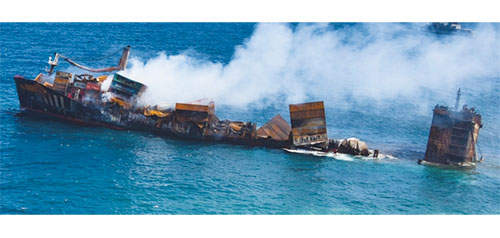Features
The Increasing Incidents of Container Ship Fires and Environmental Destruction

by Dr Manique Cooray
Fires at sea continue to pose a significant risk to container shipping and often give rise to long-winded and complex claims between all affected parties. Space does not permit even a cursory examination of the large body of relevant international legal provisions available. Moreover, the rise of containerisation has exacerbated the problem of fire on board ships as we have seen with the MV Hansa Brandenburg, the Jolly Rubino, the Maersk Londrina and recently in February 2017, in the MV APL Austria case where a Liberian flagged container ship caught fire off the Eastern Cape of South Africa.
In the backdrop of the ongoing environmental catastrophe in one of Sri Lanka’s worst ever marine disasters, it is imperative to address two issues that seem to be of central importance pertaining to the cargo ship carrying tonnes of chemicals which now lie in the seabed off the west coast of the Island. The Singapore registered MV X-Press Pearl, Super Eco 2700-class container ship was built by Zhoushan Changhong International Shipyard Co. Ltd at Zhoushan, China, for Singapore based X-Press Feeders and its sister ship X-Press Mekong. The 37,000 dead weight tonne (DWT) container vessel could carry 2,743 twenty-foot equivalent units. The ship was delivered on February 10, 2021. It had a 25-member crew including Filipinos, Chinese, Indian and Russian nationals. It was carrying 1,486 containers, among them 81 carrying dangerous goods, which included 25 tonnes of nitric acid, along with other chemicals, cosmetics and low-density polyethylene (LDPE) pellets. Reports indicate the vessel was deployed in the Straits of Malacca to Middle East (SMX) service of X-Press Feeders, from Port Klang (Malaysia) via Singapore and Jebel Ali (UAE) to Hamad Port (Qatar). The return journey to Malaysia was to be via Hazira (India) and Colombo (Sri Lanka). It was reported that the ship’s crew had noticed the leakage of nitric acid from one of the containers when the vessel set sail to the Port of Colombo.
It is common knowledge that under the United Nations Convention on the Law of the Sea, no vessel can enter a country’s “territorial water” extending up to 12 miles from the nearest land without approval from the coastal state. Nevertheless, bearing in mind that Sri Lanka is a signatory to the Basel Convention, it is not the aim here to address basic questions on how, why and who authorized a vessel with a container leaking nitric acid to enter the territorial waters of the country carrying hazardous material. This entry into Sri Lankan waters could have been under “Port of Refuge”, a situation wherein a ship deviates to a port due to an emergency which renders the ship unsafe to continue on her voyage.
The ill-fated ship erupted in a fire while anchored about 9.5 nautical miles northwest of Colombo. The Sri Lankan navy believes the fire was caused by a chemical reaction from the leaking cargo loaded from the port of Hazira in India. As flaming containers laden with chemicals fell from the ship’s deck, seawater may have entered the hull that submerged the MV X-Press Pearl’s quarterdeck a day after firefighters extinguished the fire. With such a dramatic turn of events of an overseas registered ship, carrying crewmen of various nationalities and cargo belonging presumably to various parties, and with a vessel located within the territorial waters of Sri Lanka, presents itself a plethora of issues in conflict of laws determining principles of choice of law with recognition and enforcement of foreign judgments.
While the local authorities are moving to sue the owners of the vessel to claim damages from the insurer, the suitability of existing Penal Provisions and the Marine Pollution Prevention Act No 35 of 2008 of Sri Lanka raises the question of its adequacy as the principle legislation of the forum state to hear a case of such magnitude of which the main issue is to claim compensation. Insurers of cargo vessels generally require the owners and operators to adhere to internationally recognized guidance concerned with maximizing the overall safety of the vessel, the crew and the cargo. One part of the guidance is the International Maritime Organizations Dangerous Goods Code (IMDG Code), an internationally accepted guideline for the transportation or shipment of dangerous goods or materials by a vessel on water.
Even a cargo that might be quite innocuous in small quantities can display dangerous properties when transported in large quantities, especially if those large quantities of material are exposed to environmental conditions such as moisture or heat, during or prior to loading, or during a voyage. Under the Hague-Visby Rules, the liability regime for the carriage of most cargo, neither the carrier nor the shipowner is responsible for loss or damage arising or resulting from fire unless caused by the actual fault or privity of the shipowner or carrier. To successfully recover for damage to cargo from the shipowner or to defend a claim for general average, the cargo owner must show a lack of due diligence of the shipowner to make the ship seaworthy and safe to receive, carry and discharge the cargo. From a procedural perspective, “(i) the cargo owner must prove their loss; (ii) the carrier or shipowner must prove the cause of loss (i.e., that the fire caused the loss); (iii) the carrier or shipowner must prove due diligence to make the ship seaworthy prior to and at the commencement of the voyage; and (iv) the cargo owner must prove fault of the carrier or shipowner or knowledge of fault or another for whom the carrier or shipowner is responsible.”
The shipowner is not liable for an act or omission by the crew. If the negligence of the crew caused the fire, this is a complete defence for the shipowner unless the cargo owner can show that there was some lack of due diligence by the shipowner, which made the ship unseaworthy. In the case of fires at sea, this would include the shipowner failing to exercise due diligence insofar as the crew fighting the fire is concerned, a lack of adequate firefighting systems, lack of training, or lack of procedural guidance from owner or carriers to the crew. Cargo owners are also likely to be successful in claiming against a shipowner where it is shown that the shipowner or carrier failed to correctly stow dangerous or hazardous cargo (provided that such cargo was correctly declared) in accordance with IMDG guidelines. In the event a shipowner can rely on a “fire defence”, the cargo owner (or their insurers) may be left with a recovery action against the shipper of the miss declared cargo. However, this often involves expensive litigation in a foreign jurisdiction where the “guilty” shipper may be a brass plate company without any assets to satisfy millions of dollars worth of damages to the ship and her cargo and let alone the environmental aftermath. This means that the insurer may be liable, and the affected party could claim compensation from the shipowner.
From the brief facts at hand, it appears to be a total loss for the shipowner even if the vessel stays afloat with what appears to be, if not all, of the cargo, damaged. Although there is much uncertainty over the size of the loss, it is safe to assume that insurers will face cargo and liability claims and the value of the hull and machinery. The value of these claims have not yet been made known. It is highly possible for the fire and explosion losses to be covered under cargo insurance policies among various companies which are party to it. The London Steam Ship Owners Mutual Insurance Association Ltd and its subsidiary, the London P&I Insurance Company (Europe) Ltd, in a press statement on May 26, 2021, stated that as the “liability insurer, it would cover crew injuries and any environmental impact.” A study of previous cases of similar nature indicates that a vessel sinking in deep water perhaps is a better outcome for the insurer than saving it and bringing it back to port with the heavy cleanup costs incurred. Perhaps in this current scenario, the P&I insurer could end up covering the cargo and salvage costs.
The environmental impact of the fire could have a significant bearing on the size of the P&I claim leading to potentially hundreds of millions, as previous cases have shown us. It is well to keep in mind that while the owners of the ship are maybe accountable for bringing the ship to the territorial waters, the local authorities themselves may have a share in their contribution by their bad choice of actions. It is highly questionable whether adequate compensation could be secured given the larger environmental impact (an impact which may be seen beyond the limitation period for such claims to be brought) under the existing lacuna in the local law. Hence, the importance of the forum state to take on such a mammoth legal action against the parties possibly raises the issues of whether recourse should be made to an international maritime arbitration tribunal permitting contractual arrangements.
The second issue to be addressed is whether a special legal regime in the nature of strict liability is needed to cover the irreparable damage caused to the Sri Lankan Sea, marine lives, including the coral reefs and the fisheries industry. There is now an additional danger that fuel tanks of the stricken vessel containing thousands of tons of thick bunker oil could break up under the pressure of the seawater and discharge its deadly cargo into the ocean. The Wildlife Conservation Department of Sri Lanka states that apart from the fish species, the harm done to seagrasses and nesting habitats, sea mammals, and reptiles will also be substantial and that their “initial observations reveal the spill-over effect will last for more than 100 years.” The illustration of the Exxon Valdez’s incident in 1989 and the Deepwater Horizon accident in the Gulf of Mexico in 2010 indicates that the oil spill is a severe threat to the maritime environment. A review of this incident may be a good reference to seek a fair understanding of the circumstances and for proper estimation and preparation in encountering massive oil spills.
The harm caused by many environmental incidents are not only contained within the borders of the states, but pollution originating from one state may cause harm to another state. And pollution which damages the Oceans does not belong to one state alone. This type of harm raises a number of acute legal conundrums. Establishing causal connections between effects such as damage to marine life or extinction of species and a particular source of pollution, which could be targeted by a system of liability and compensation rules, may be extremely difficult. In the absence of intergovernmental compensation regimes or where individual states seek compensation for cross border pollution, claims must be made in domestic courts. In such situations, the importance of conflict of laws rules about jurisdiction, choice of law, and recognition of judgments matters. One could plausibly conclude that X-Press Pearl too may find its unfortunate place in legal history for the colossal task it has presented of assessing harm to the environment caused in a line of container ship losses in the maritime insurance industry.
(The writer is a Senior Lecturer at the Faculty of Law, Multimedia University. Malaysia and was the Dean of the Faculty of Law from 2014-2016 and 2018-2021.)
Features
‘Silent Majority’ abandoned to Long-suffering in regional conflicts

 With reports emerging that India has attacked some ‘sites’ in Pakistan and Pakistan-administered Kashmir, the question could be posed whether the stage has just been set for yet another costly India-Pakistan military conflict. Sensible opinion in South Asia could only hope that wise counsel would sooner rather than later come to prevail on both sides of the divide and that they would draw back from the brink of full-scale war.
With reports emerging that India has attacked some ‘sites’ in Pakistan and Pakistan-administered Kashmir, the question could be posed whether the stage has just been set for yet another costly India-Pakistan military conflict. Sensible opinion in South Asia could only hope that wise counsel would sooner rather than later come to prevail on both sides of the divide and that they would draw back from the brink of full-scale war.
The states concerned ought to know fully well the possible wide-ranging weighty consequences of another regional conflict. It should be plain to see that it would benefit none in the two theatres of confrontation, most particularly the relevant publics or the ‘Silent Majority’.
In fact, in connection with the mentioned initial military attacks, the Pakistani side has gone on record that some civilian lives have been lost. Such losses could burgeon in the event of full scale hostilities. These costs could of course be staggering and unimaginable in the event the nuclear option is resorted to by the sides, going forward.
Accordingly, the hope of the peace-loving world-wide is likely to be that India and Pakistan would give negotiations a chance and resolve their differences peacefully. It would be in the best interests of the world for the champions of peace to join their voices to that of UN chief Antonio Guterres and call on the sides to negotiate an end to their differences.
The utter helplessness and misery of the people of the Gaza ought to drive home afresh the horrors of war. Currently the news is that the Gazans are literally starving to death. Food and other essentials provided by UN agencies are reportedly being prevented by Israel from getting to the hapless people of Gaza. So dire is their situation that concerned quarters are calling on the compassionate worldwide to provide the Gazans with food, water and other essentials voluntarily. This SOS would need to be heeded forthwith.
Accordingly, it could be inferred that most formal arrangements, including those that are generally under the purview of the UN, geared to providing emergency humanitarian assistance to the needy, have, for all intents and purposes, been rendered ineffective in the Gaza. The UN cannot be faulted for this state of things; rather, Israel should be held accountable in the main for it.
The matter of accountability is central to the dramatic slide into lawlessness the world has been experiencing over the past few decades. As could be seen, International Law is no longer fully applicable in the conflict and war zones of the world because it is not being adhered to by many state and non-state aggressors. That the UN is hapless in the face of such lawlessness is plain to see.
We have of course the Middle East wherein International Law has fallen silent for quite a while. How could it be otherwise, when Israeli aggressions are being winked at by the US, for which the policy of backing Israel is almost sacrosanct?
Moreover, under President Donald Trump, it is difficult to see the US changing policy course on the Middle East. Trump made vague promises of bringing peace to the region in the run-up to his reelection but has done nothing concrete by way of peace-making. Consequently, complete lawlessness prevails in the Middle East. US policy towards Israel counts as another example of how the self- interest of US central administrations blinds them to their international obligations, in this case Middle East peace.
However, the commentator could be criticized as being biased if he holds only Israel responsible for what has befallen the Middle East. It has been the position of this columnist that Israel’s security needs should be taken cognizance of by its state and non-state adversaries in the Middle East and acted upon if the basis is to be laid for a durable Middle East peace. Inasmuch as Palestinian statehood must be guaranteed, the same should be seen as applicable to Israel. The latter too enjoys the right to live in a secure state of its own, unopposed by its neighbours.
The Ukraine of today is also sad testimony to the ill consequences of powerful, aggressor states wantonly disregarding International Law and its obligations. Nothing could justify Russia in invading Ukraine and subjecting it to a condition of Longsuffering. Clearly, Ukraine’s sovereignty has been violated and such excesses go to the heart of the current state of ‘International Disorder’. Of course the same stricture applies to the US in relation to its military misadventures in Afghanistan and Iraq, to name just two such modern examples.
There is no ducking the fact, then, that civilian publics in the mentioned theatres of war and outside, are being subjected to the worst suffering as a consequence of the big powers’ self-aggrandizement schemes and military misadventures. Longsuffering becomes the tragic lot of the people who have nothing to do with such unbridled power ambitions.
One would not be exaggerating the case if he states that civilian publics count for almost nothing in the present ‘International Disorder’. Increasingly it is becoming evident that from the viewpoint of the big powers and authoritarian governments the people are of little or no importance. Considering that self-aggrandizement is of the paramount interest for the former the public interest is coming to be seen as inconsequential.
Consequently, not much of a case could be made currently for the once almost reverentially spoken of ‘Social Contract’. For, the public interest does not count for much in the scrambles for power among the major powers who are seen at the popular level as the principal history-makers.
It is in view of the above that much is expected of India. Today the latter is a ‘Swing State’ of the first importance. Besides being a major democracy, it is one of the world’s principal economic and military powers. It possesses abundant potential to help to put things right in international politics. If there is one state in Asia that could help in restoring respect for International Law, it is India.
Considering the above, India, one believes, is obliged to bear the responsibility of keeping South Asia free of any more long-running, wasting wars that could aggravate the material hardships and socio-economic blights of the region. Thus, India would need to consider it imperative to negotiating peace with Pakistan.
Features
Memorable happening … Down Under

 Under the Global-Ise Australia Advanced Sports Development Programme, a delegation of 15 swimmers from Lyceum International School, Wattala, had the remarkable opportunity to train and experience high-performance sports development in Melbourne, Australia.
Under the Global-Ise Australia Advanced Sports Development Programme, a delegation of 15 swimmers from Lyceum International School, Wattala, had the remarkable opportunity to train and experience high-performance sports development in Melbourne, Australia.
The 10-day programme was carefully curated to offer intensive training, educational exposure, and cultural experiences for the young athletes.
The swimmers underwent specialised training through Swimming Victoria’s elite programme, held at some of Melbourne’s premier aquatic facilities.

Visit to Victorian Parliament
Each day began as early as 5:00 a.m. and continued until 7:00 p.m., ensuring a rigorous and enriching schedule that mirrored the standards of international competitive swimming.
Beyond training, the programme offered a wide array of experiences to broaden the students’ horizons.

Morning training
The tour group explored iconic landmarks such as the Victorian Parliament and the Melbourne Cricket Ground (MCG), and enjoyed shopping at Chadstone – The Fashion Capital. They also experienced the natural beauty of Victoria with visits to Yarra Valley Chocolaterie & Ice Creamery, and Cardinia Reservoir Park, where they observed kangaroos in their natural habitat.
An academic highlight of the tour was the group’s exclusive visits to three of Australia’s leading universities: the University of Melbourne, Monash University, and Deakin University. These visits aimed to inspire students and showcase the vast educational opportunities available in Australia.

Checking out the scene at Yarra Valley Chocolaterie & Ice Creamery
As part of the cultural immersion, Global-Ise hosted a traditional Australian BBQ at the Tim Neville Arboretum in Ferntree Gully. The students also enjoyed a variety of diverse culinary experiences each evening, further enriching their understanding of local and international food cultures.
The tour concluded with a celebratory dinner at the Spicy Wicket Restaurant, where each participant received a presentation in recognition of their involvement.

Enjoying an Aussie BBQ for lunch
The evening was made especially memorable by the presence of Pradeepa Saram, Consul General of Sri Lanka in Victoria.
Global-Ise Management—Ken Jacobs, Johann Jayasinha, and Dr Luckmika Perera (Consultant from the University of Melbourne)—did a magnificent job in planning and the execution of the advanced sports programme.

Coaches from Sri Lanka presenting a plaque to Global-Ise Management team
Ken Jacobs (centre), Johann Jayasinha, and Dr Luckmika Perera (on the right
Features
Bright, Smooth Skin

 Hi! How’s the beauty scene keeping with you?
Hi! How’s the beauty scene keeping with you?
Phew, this heat is awful but there is nothing that we can do about it.
However, there are ways and means to take care of your skin and I will do my best to help you in every way I can.
Well, this week, let’s go for a Bright, Smooth Skin.
Gram flour (also known as besan) is a traditional skincare ingredient known for its:
* Natural exfoliating properties.
* Ability to absorb excess oil.
* Gentle brightening and tan-removal effects.
* Suitability for all skin types, especially oily and acne-prone skin.
You will need 01–02 tablespoons gram flour (besan) and rose water, or raw milk, to make a paste.
You could add the following two as optional add-ins: A pinch of turmeric (for extra glow), and a few drops of lemon juice (for oily skin and pigmentation)
Add the gram flour to a small bowl and mix in the rose water (for oily/sensitive skin) or raw milk (for dry skin) slowly.
Stir well to make a smooth, spreadable paste—not too thick, not too runny.
Now apply this mixture, evenly, to your damp face and neck, and let it sit for 5–10 minutes (don’t let it dry completely if you have dry skin).
Gently massage in circular motions using wet fingers—this helps exfoliate.
Rinse off with lukewarm water, and then pat your skin dry.
Use it 02–03 times a week for best results.
Skin Benefits:
* Removes dirt, sweat, and oil without stripping natural moisture.
* Gently exfoliates dead skin cells, revealing smoother skin.
* Brightens the complexion and fades mild tanning.
* Helps clear clogged pores and reduce pimples.
* Leaves skin fresh and glowing—perfect for humid climates.
-

 News6 days ago
News6 days agoRanil’s Chief Security Officer transferred to KKS
-

 Opinion5 days ago
Opinion5 days agoRemembering Dr. Samuel Mathew: A Heart that Healed Countless Lives
-

 Business2 days ago
Business2 days agoAitken Spence Travels continues its leadership as the only Travelife-Certified DMC in Sri Lanka
-

 Business3 days ago
Business3 days agoLinearSix and InsureMO® expand partnership
-

 Latest News1 day ago
Latest News1 day agoNPP win Maharagama Urban Council
-

 Business7 days ago
Business7 days agoCCPI in April 2025 signals a further easing of deflationary conditions
-

 Features7 days ago
Features7 days agoExpensive to die; worship fervour eclipses piety
-

 Features5 days ago
Features5 days agoTrump’s economic missiles are boomeranging











